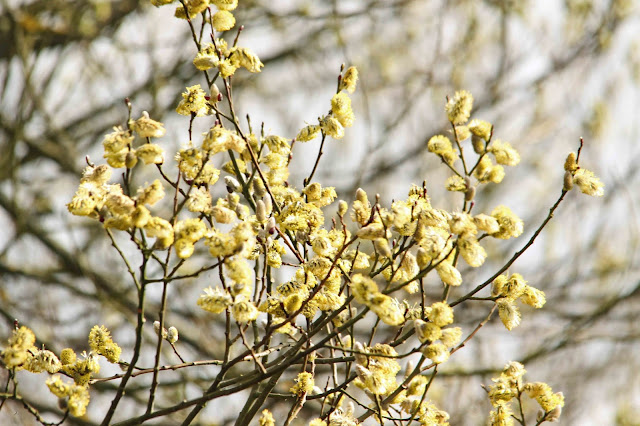Andrena are really fascinating solitary bees and there must be so much to learn about their mysterious lives. Today I was hoping for hoverflies but also came across quite a few
Andrena which seemed to be flying in the canopy of trees. For example first there were quite a few
Andrena in the twigs and branches of the Great Sallow bushes,
Salix caprea, by the Red Pond along the Access Trail, of which I only caught one.
I don't know for sure that there were any more bees here than anywhere else, all I can really say is that I spent quite some time looking for hoverflies there, and that I saw mainly bumblebees visiting the catkins and mainly
Andrena bees in amongst, and occasionally settling on, the branches. I think the Andrena may also have visited the catkins rarely, but I got the impression that most of the time they were not looking for food, just flying. I imagine that if you are a bee subject to predation by birds, then you are probably safer in amongst the twigs and branches, than out in the open. However I do also wonder whether there is a social feature in gathering together as well.
After quite a lot of time by the Red Pond I moved down to the riverplain of the River Bourne and ended up looking for bees on the dandelions in the damp meadow by Bourneside Farm. There was almost nothing there, but it was getting on towards 4 in the afternoon and I rather suspect the dandelions become less attractive to insects after about the middle of the afternoon.
There was at least one chiff-chaff in the treeline along the boundary with the land below Easterfield Bungalow, and while trying to get photographs there of the opening leaves of the native Common Alder,
Alnus glutinosa, I saw some rapidly flying insects moving quickly in, and just outside the edge of, the canopy of the trees at about head height. They were moving so fast I couldn't even tell for sure whether they were bees or flies and I spent a lot of time trying, and failing (I need a bigger net?), to catch one. I would say that as far as numbers go, there were at least half a dozen and probably into double figures as a total. In the end I eventually caught one insect and that turned out to be a male
Andrena haemorrhoa upon closer examination and under the binocular microscope. The insects did all look quite similar in size and "jizz" and if asked I would have said it was more likely that they were all males, rather than a mix of males and females, and possibly all of the same species.
I have found
Andrena haemorrhoa in several places in the local area, but this seemed to be a specific association with these trees and also a specific behaviour. It could be that the bees were commuting back and forwards along the tree line towards a food source or other site, or perhaps they were just flying to and from with some sort of social purpose. It would be useful to see if the behaviour is repeated on different days and times of day, and also to see if the all the insects are really all male
Andrena haemorrhoa.
Here is a picture of one, this time a female, I took a few hundred metres away up on the Access trail in May last year:
You can see the foxy red colour of the hairs on the thorax (even more intense in the female as compared to the male), the whitish hairs around the face, the orange-red hairs on the tail, and the rather shiny black colour of the main dorsal surface of the abdomen.
The unfolding alder leaves were very difficult to photograph because of the shallow depth of field. As the buds swell the two main scales may part slightly, partly exposing the leaves within.
The scales then roll fully back on themselves, allowing the leaves to start their main phase of expansion, looking slightly shiny or possibly sticky.










